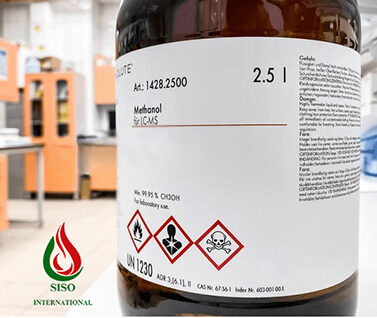Methanol
Methyl Alcohol

Methanol, also known as methyl alcohol or wood alcohol, is a colorless, flammable liquid with the chemical formula CH3OH. It is the simplest alcohol
Methanol is primarily produced via the catalytic reaction of carbon monoxide and hydrogen or It can also be obtained from natural gas or biomass by various methods.
Some of Methanol physical and chemical properties:
- Molecular Formula: CH3OH
- Molecular Weight: 32.04 g/mol
- Boiling Point: 64.7 degrees Celsius
- Melting Point: -97.6 degrees Celsius
- Density: 0.7918 g/cm³
- Solubility: Miscible in water
- Purity: Industrial-grade methanol typically has a purity of 99.85% or higher.
- Flash Point: It has a low flash point of around 11 degrees Celsius, making it highly flammable.
- Water Content: Low water content is essential; as excess water can affect its performance in various applications.
- Odor: Methanol has a distinctive, sweet odor.
- Color: Pure methanol is colorless, and any impurities may give it a slight color.
- Toxicity: Methanol is toxic to humans and should be handled with care. It can be absorbed through the skin or inhalation and should not be ingested.
Application :
Solvent: It serves as a solvent in various chemical processes and industries, including pharmaceuticals and the production of paints and varnishes.
Chemical Feedstock: Methanol is a vital building block for various chemicals and products, including formaldehyde, acetic acid, and plastics like polyethylene and polypropylene.
Antifreeze: Methanol is used in antifreeze solutions, often mixed with water, to lower the freezing point of the liquid in radiators and prevent engine damage during cold weather.
Fuel: Methanol is used as an alternative fuel in some engines, particularly in racing cars. It’s also used as a fuel additive to improve combustion in internal combustion engines.
Biofuel Production: Methanol is considered a potential biofuel for the future, as it can be produced from biomass or waste materials, offering a renewable energy source.
Energy Storage: Methanol can be used as a means of energy storage, particularly in fuel cells, which can convert methanol into electricity.
There are two types of methanol: industrial methanol and denatured methanol.
Choosing between industrial methanol and denatured methanol depends on the specific usage and regulatory requirements. Industrial methanol is used in situations where high purity and specific chemical properties are necessary, while denatured methanol is selected when the primary concern is preventing human consumption and obtaining tax benefits for certain uses.
|
Property |
Specification |
Analytical Test Methanol |
|
Purity WT % |
99.85 Min. |
IMPCA 001-21 |
|
Water W/W % |
0.100 Max. |
ASTM E-1064 |
|
Ethanol W/W % |
0.0050 Max. |
IMPCA 001-21 |
|
Specific Gravity 20/20, °C |
0.7928 Max. |
ASTM D-4052 |
|
Acetone, W/W % |
0.0030 Max. |
IMPCA 001-21 |
|
Permanganate Time Test @ 15ºC,Minutes |
60 Min. |
ASTM D-1363 |
|
Non Volatile Matter, mg/1000 ml |
8 Max. |
ASTM D-1353 |
|
Distillation range @ 760 mm-Hg, °C |
1.0 Max. |
ASTM D-1078 |
|
Color Pt- Co, APHA |
5 Max. |
ASTM D-1209 |
|
Carbonizable, APHA |
30 Max. |
ASTM E-346 |
|
Total Iron, mg/kg |
0.10 Max. |
ASTM E-394 |
|
Chloride as Cl¯ , mg/kg |
0.5 Max. |
ASTM D-512 |
|
Appearance |
Clear and Free from Suspended Matter |
IMPCA 003-98 |
|
Acidity as CH3COOH, W/W % Hydrocarbons |
0.0030 Max. Passes Test |
ASTM D-1613 ASTM D-1722 |
|
Sulphur, mg/kg |
0.5 Max. |
ASTM D-5623 |
|
Aromatics, UV Test |
Passes Test |
IMPCA 004-15 |
For more information on the product grades and data sheet, please feel free to contact us
